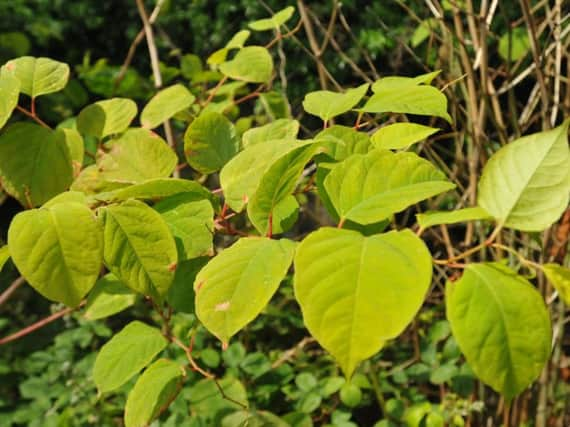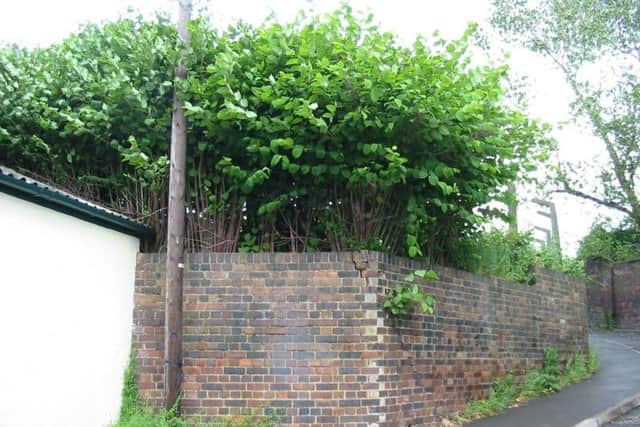Scarborough in top ten worst areas in Yorkshire affected by Japanese knotweed


The research, conducted by Environet UK, show that the town has eight infestations within 4km putting it at number ten on the list. It is also the only location in North Yorkshire to feature on the top 10.
Advertisement
Hide AdAdvertisement
Hide AdRotherham tops the list with 318 infestations within 4km, followed by Mexborough and Sheffield with 235 and 149 respectively.


Described by the Environment Agency as “indisputably the UK’s most aggressive, destructive and invasive plant”, Japanese knotweed grows along railways, waterways, in parks and gardens and is notoriously difficult to treat without professional help.
Environet has mined data from its online heatmap which records Japanese knotweed sightings across the UK.
Nic Seal, Founder and MD of Environet, said, “Japanese knotweed has become a major problem in Yorkshire and the Humber. It is impacting property prices, halting sales and causing a huge amount of stress and worry for homeowners.
Advertisement
Hide AdAdvertisement
Hide Ad“Anyone thinking about buying a property in the region, particularly in these hotspots, would be wise to check the number of infestations in the proximity of their postcode and consider instructing a Japanese knotweed survey on the property.”
What can the plant mean for homeowners?
Japanese knotweed can deter buyers, making a property difficult to sell and can prevent a mortgage lender approving a loan unless a treatment plan is in place.
Sellers are required by law to inform potential purchasers whether their home is, or has been, affected by Japanese knotweed.
Property owners who fail to stop the spread of the plant on their land can face fines and even a jail sentence.
Advertisement
Hide AdAdvertisement
Hide AdEnvironet estimates that Japanese knotweed currently affects 4 to 5 per cent of UK properties, wiping a total of £20 billion off house prices.
Homeowners who are concerned about infestations near their home could consider purchasing a specialist indemnity policy, which covers them for the cost of treatment, repairs, legal costs and any diminution of the property’s value, should knotweed arise.
What exactly is Japanese knotweed?
Japanese knotweed arrived in the UK in the 1840s, in box number 34 of 40 Chinese and Japanese plant species delivered to Kew Gardens.
Advertisement
Hide AdAdvertisement
Hide AdThe plant grows at the incredible rate of around 10cm a day from May until July and when fully grown can reach 3 metres tall.
Knotweed blooms in late summer, when it becomes covered in tiny creamy-white flowers.
Approximately £166 million is spent each year on treating the plant in the UK and the Government estimates it would cost £1.5 billion to clear the UK of knotweed.
It can lie dormant under the ground for up to 20 years before suddenly re-growing.
The Complete Top 10
1. Rotherham, South Yorkshire - 318 infestations within 4km
Advertisement
Hide AdAdvertisement
Hide Ad2. Mexborough, South Yorkshire - 235 infestations within 4km
3. Sheffield, South Yorkshire - 149 infestations within 4km
4. Todmorden, West Yorkshire - 97 infestations within 4km
5. Cudworth, South Yorkshire - 79 infestations within 4km
6. Kingston upon Hull, East Yorkshire - 51 infestations within 4km
7. Wakefield, West Yorkshire - 50 infestations within 4km
8. Huddersfield, West Yorkshire - 44 infestations within 4km
9. Leeds, West Yorkshire - 35 infestations within 4km
10. Scarborough, North Yorkshire - 8 infestations within 4km
To view infestations in your area or to report a sighting visit Environet's Japanese knotweed heatmap.